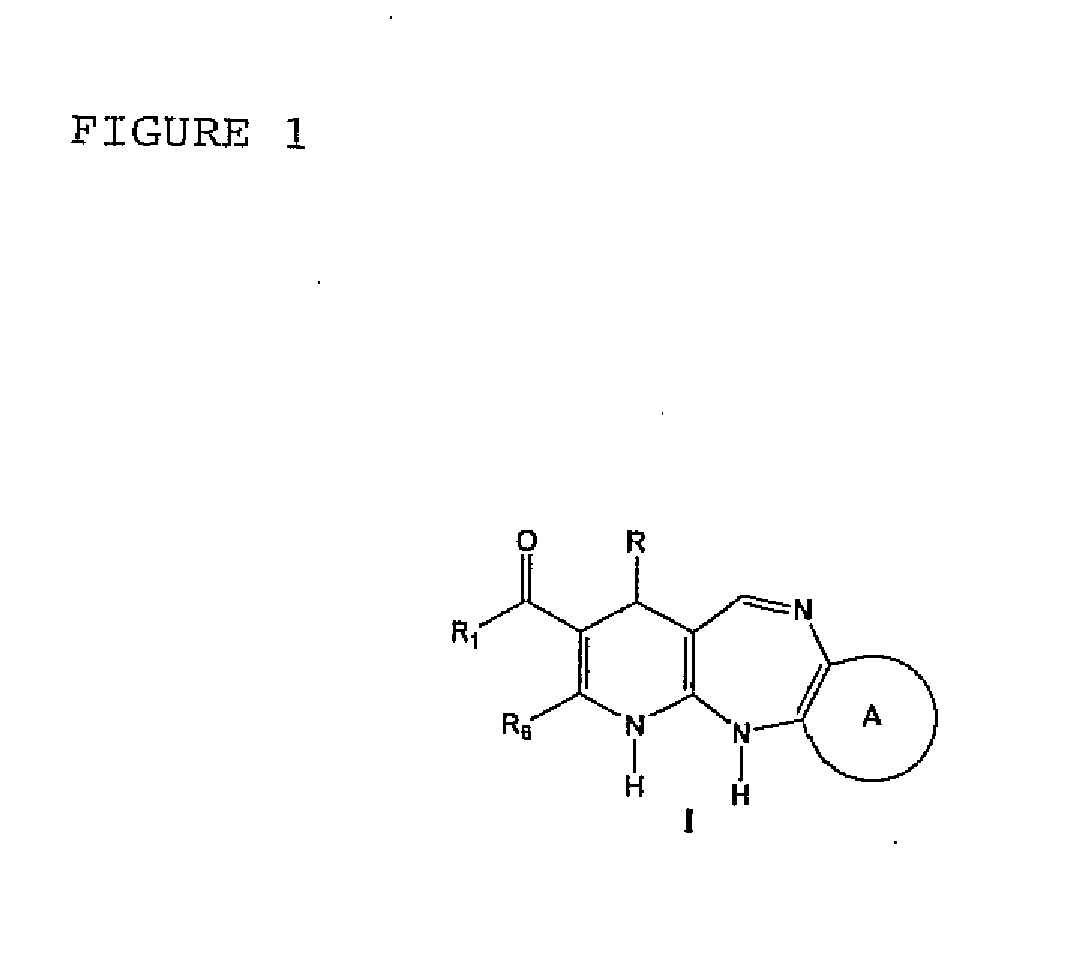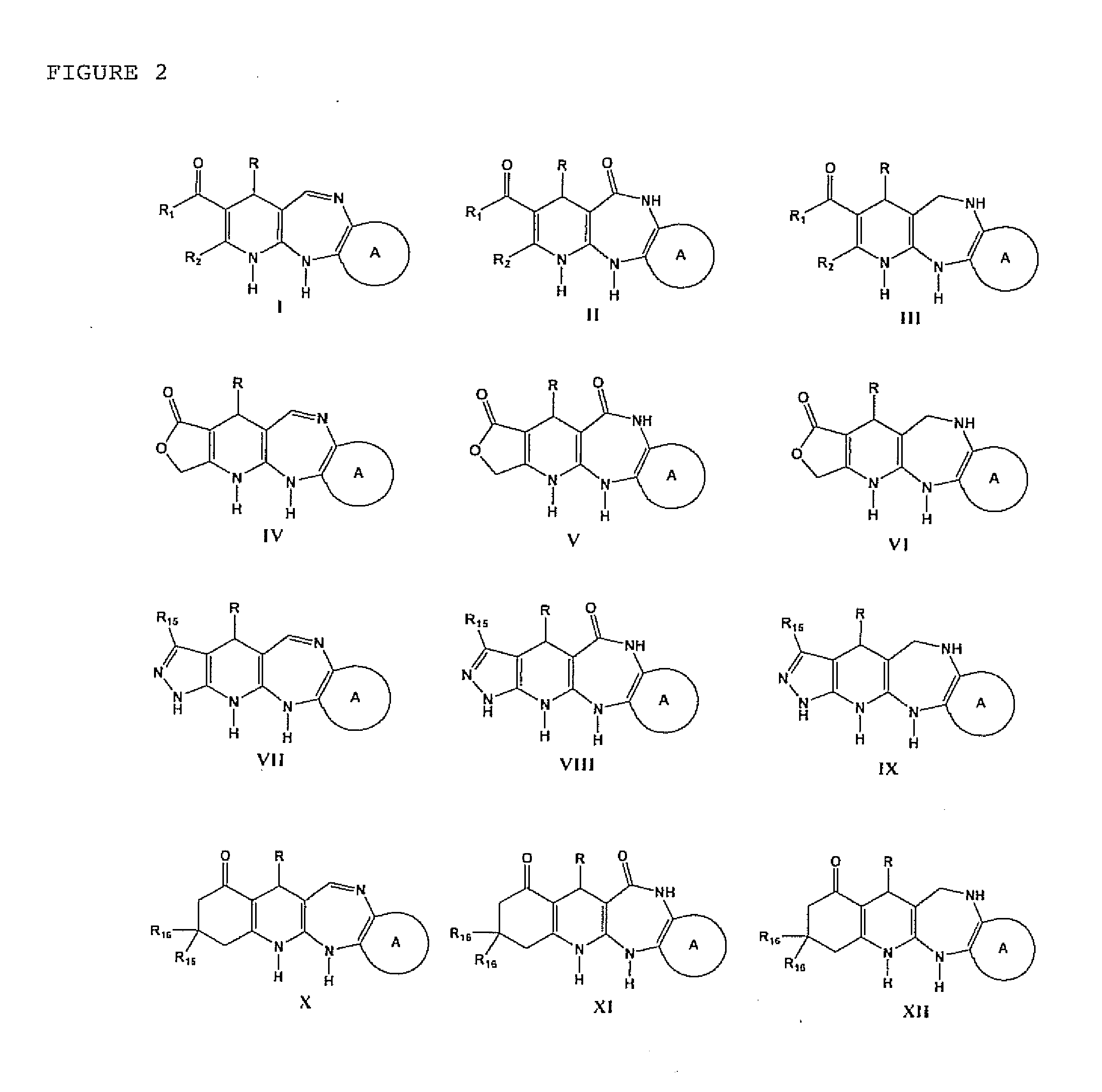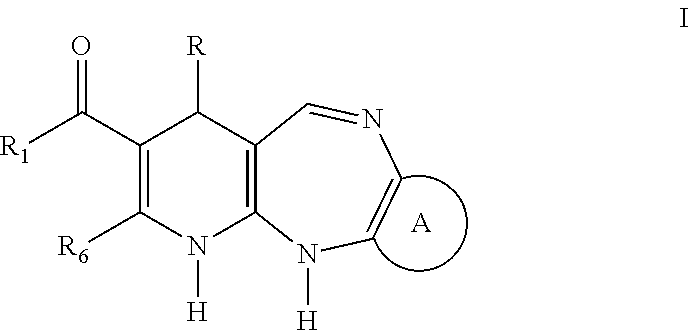Tricyclic and Tetracyclic Systems with Activity on the Central Nervous and Vascular Systems
a technology of tetracyclic system and tetracyclic nucleus, which is applied in the field of chemical and pharmaceutical, can solve the problem that the fusion of these nucleus cannot be described to form a new pharmacologic entity
- Summary
- Abstract
- Description
- Claims
- Application Information
AI Technical Summary
Benefits of technology
Problems solved by technology
Method used
Image
Examples
example 1
Synthesis of the 4-aryl-5-carbonyloxy-6-methyl-2-oxo-1,2,3,4-tetrahydropyridine Synthetic Intermediary Useful for Preparing Compounds of the I, II, III, IV, V, VI, VII, XIII, AND IX Type
[0043]The 4-aryl-5-carbonyloxy-6-methyl-2-oxo-1,2,3,4-tetrahydropyridines derivatives are part of the synthetic intermediaries required to obtain the final products. In a 100 mL flask provided with a reflux condenser, 5.76 g (40 mmol) of Meldrum acid are dissolved in 40 mL of glacial acetic acid, acetonitrile or ethanol. Then, 40 mmol of the corresponding aromatic aldehyde are added, together with 40 mmol of the given dicarbonyl compound that can be acetyl-acetone, methyl-acetoacetate, ethyl-acetoacetate or any other commercial or previously prepared dicarbonyl compound, and 3.46 g (45 mmol) ammonium acetate. The reaction mixture is heated to reflux for about 8 to 16 hours. Then it is poured into cold water and the precipitated solid is vacuum filtered and recrystallized with ethanol.
example 2
Synthesis of the Synthetic Intermediary Derived From 4-aryl-5-carbonylacohoxy-6-methyl-2-oxo-1,2,3,4-tetrahydropyridine, Useful for Preparing Compounds of the X, XI, AND XII, Type
Method 1
[0044]1.44 g (10 mmol) of Meldrum acid are dissolved in 10 mL of glacial acetic acid and 10 mmol of the corresponding aromatic aldehyde are added together with 1.40 g (10 mmol) of another dicarbonyl cyclic compound that could be Dimedone, and 0.7 g (10 mmol) of ammonium acetate. The reaction mixture is heated to reflux for 20 to 35 hours. Once the reaction ends, the mixture is poured into cold water and the precipitated solid is filtered and recrystallized with the proper solvent.
Method 2.
[0045]The technique described in EXAMPLE 1, METHOD 1, is used by adding to the mixture of reaction 0.8 mmol, 0.14 g of p-toluensulfonic acid between 4 and 10 hours. The isolation procedure and purification is the same one that for the METHOD 1.
Method 2.
[0046]10 mmoles of 5-X-ariliden-derived were dissolved such a...
example 3
Synthesis of 4-aryl-3-carbonylalcohoxy-2-alkyl-6-chloro-5-formyl-1,4-dihydropyridine Synthetic Intermediary
[0047]The 4-aryl-3-carbonylalcohoxy-2-alkyl (or aryl)-6-chlorine-5-formyl-1,4-dihydropyridine derivatives are also synthesis intermediaries. To an N,N-dimethylformamide solution in anhydrous chloroform, an equimolar quantity of phosphorus oxychloride is added at room temperature. After a while, a solution of the corresponding 4-aryl-5-carbonylacohoxi-6-alkyl-2-oxo-1,2,3,4-tetrahydropyridine derivative is added. It is then stirred at room temperature for approximately 10-20 hours. Then, a sodium acetate aqueous solution is added and it is stirred for 10 to 30 minutes. The organic phase is separated and the solvent is vacuum-filtered. The solid obtained is recrystallized with ethanol.
PUM
| Property | Measurement | Unit |
|---|---|---|
| Therapeutic | aaaaa | aaaaa |
Abstract
Description
Claims
Application Information
 Login to View More
Login to View More - R&D
- Intellectual Property
- Life Sciences
- Materials
- Tech Scout
- Unparalleled Data Quality
- Higher Quality Content
- 60% Fewer Hallucinations
Browse by: Latest US Patents, China's latest patents, Technical Efficacy Thesaurus, Application Domain, Technology Topic, Popular Technical Reports.
© 2025 PatSnap. All rights reserved.Legal|Privacy policy|Modern Slavery Act Transparency Statement|Sitemap|About US| Contact US: help@patsnap.com



